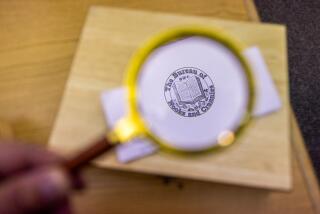Animated ABCs Magically Spell F-U-N
- Share via
It’s rare when I sit back and say “Wow!” But it happened recently as I took a peek at “Alphabet,” a software title based on a picture book by Czech artist Kveta Pacovska. “Alphabet” creates a constantly changing environment in which a child’s actions affect what appears on the screen.
“Alphabet” begins with a series of scenes full of animated letters. In this “Fantasia”-like world, letters appear randomly and are said aloud. Children control the order of presentation by hitting a specific key on the keyboard.
The letters of the alphabet might form a quilt of multicolored O’s or appear to be doing the wave across the screen. As they spin, fade in and out, swirl and sweep, they create fascinating patterns. Pacovska’s use of bright and bold colors creates a striking palette of letters.
There are two ways to play in this dramatic environment. If children click on a letter as it appears on the screen, they activate an activity related to that letter. Clicking in the upper right-hand corner of the screen also can trigger the activities.
Each of the letter activities is different, and some letters have more than one activity. Depending on the game, children have three ways of interacting with the letters on the screen: keyboard, mouse, and microphone.
For example, with the letter M activity, if children blow into a microphone attached to the computer, rainbow pieces form new letters. The letter Q game allows children to design their own music boxes by tapping on letters on the keyboard. With the H activity, children lead objects around and through the H by moving the mouse.
“Alphabet” is unlike any other piece of children’s software. It is hard to capture its essence in words because it creates such a beautiful experience. The fluid presentation of vibrant letter paintings makes you feel like you are in an art museum. This unique kaleidoscope of sight and sound can be played by 3-year-olds, but older children will better appreciate its ingenuity.
‘GollyGee Blocks’
“GollyGee Blocks” is another highly inventive software title that creates an unusual environment in which to play. With “GollyGee,” children get to explore and create with virtual 3-D blocks.
Winner of the Parents Choice Gold Award, “GollyGee” provides children with an unlimited container of blocks. The interface is clean and simple, so children can jump right in and start experimenting. And it comes with some nifty features that are never available when building with real blocks--such as a zero-gravity environment.
The main screen presents a work space on which to build and a tool bar containing all the commands for building and decorating. Click on Shapes to find 15 basic blocks. Click on Objects and 37 additional objects or unusual block shapes appear.
Users also can choose the size of a given block or opt to define a custom-block size. Builders also can add fanciful textures and/or colors to their creations.
This computer block-building environment is ultra-cool because it offers features such as the ability to spin creations 360 degrees. Kids can view their constructions from all angles, including looking up from under the building plane.
Another neat feature is that blocks can be placed on top of or within other blocks. Other options include viewing the blocks and objects in wire-frame form or activating a button that allows stacks of blocks to be moved at once. Unlike real blocks, “GollyGee” blocks can be stretched.
“GollyGee Blocks” offers no directed play--not even sample creations. But the 3-D playground is exceedingly well designed. It provides hours of play for children who like free-form environments.
Several teachers have found this software helpful in enabling students to explore shapes, geometry and architecture. (See the showcase of creations from Erving Elementary School in Massachusetts at https://www.erving.com.)
GollyGee Software Co. even offers a free demo from its Web site at https://www.gollygee.com. With a little imagination and this software, children can build anything!
*
Jinny Gudmundsen is editor of Choosing Children’s Software magazine.
(BEGIN TEXT OF INFOBOX / INFOGRAPHIC)
The Skinny
“Alphabet”
Price: $20
Ages: 3 and older
Platform: PC/Mac
System requirements: On a PC, a Pentium 166 with 16 MB of RAM. On a Mac, a Power PC running System 7.1 with 16 MB of RAM.
Publisher: Tivola
The good: Wonderfully artistic and interactive
The bad: No directed play
Bottom line: A kaleidoscope of color and sound
*
“GollyGee Blocks”
Price: $25
Ages: 5 and older
Platform: PC/Mac
System requirements: On a PC, a Pentium 200 with 32 MB of RAM and 20 MB of available hard disk space. On a Mac, a G3 200 running System 9 with 32 MB of RAM and 20 MB of available hard disk space.
Publisher: GollyGee Software
The good: Simple interface with fanciful colors
The bad: No sample building projects
Bottom line: A fun 3-D cyber-block set
More to Read
The biggest entertainment stories
Get our big stories about Hollywood, film, television, music, arts, culture and more right in your inbox as soon as they publish.
You may occasionally receive promotional content from the Los Angeles Times.










